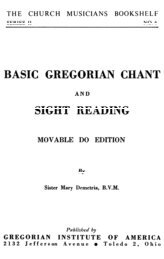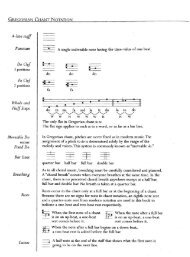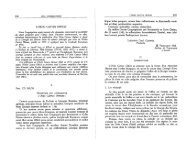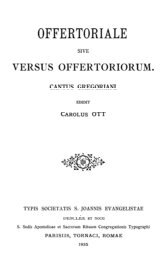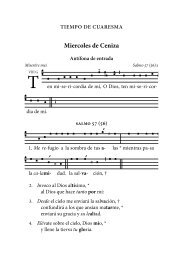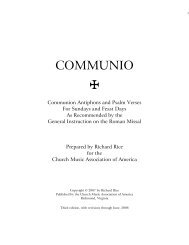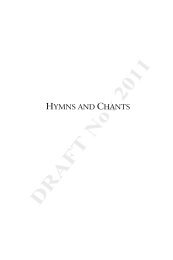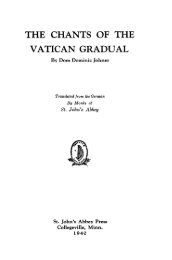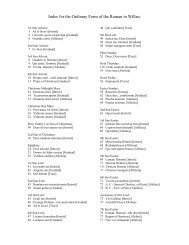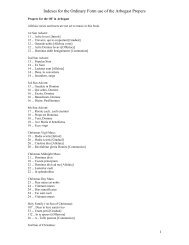William Byrd: A Celebration, edited by Richard Turget - MusicaSacra
William Byrd: A Celebration, edited by Richard Turget - MusicaSacra
William Byrd: A Celebration, edited by Richard Turget - MusicaSacra
You also want an ePaper? Increase the reach of your titles
YUMPU automatically turns print PDFs into web optimized ePapers that Google loves.
“Blame Not the Printer”: <strong>William</strong> <strong>Byrd</strong>’s Publishing Drive, 1588–1591 — 21<br />
Ariosto: it was included incongruously among the translated madrigals of Musica Transalpina,<br />
an indication that as monopolist <strong>Byrd</strong> took a managerial interest.<br />
The aim of <strong>Byrd</strong>’s musical settings was not to mirror the images or syntax of the poetry, but<br />
literally to express its form. Like a medieval musician he works with the individual lines of verse,<br />
often providing matching cadences to mirror their rhymes. His settings are syllabic and<br />
strophic; they do not aim to connect specific verbal images and musical figures, but rather to<br />
make a positive link between musical and poetic shape. If they are expressive of anything, it is<br />
the form of the poems they set. The connection with medieval insular culture is even more specific,<br />
because one of the most well-known songs in the collection, the famous “Lulla<strong>by</strong>,” is to<br />
all intents and purposes a medieval carol, replete with a refrain to each of its stanzas and an<br />
intervening burden. The aesthetic behind these songs derives from ideas which Aquinas had<br />
articulated. The luster with which <strong>Byrd</strong>’s settings adorn their serious verse enables the ear to<br />
accept the good things that may then more easily enter the mind—or to make the lover’s rhetoric<br />
more acceptable to his adored object. It is a feature of music that in our day has been used<br />
more <strong>by</strong> capitalism than <strong>by</strong> religion or moral philosophy; but its efficacy has never been in<br />
doubt, and <strong>Byrd</strong> was never more supreme as an artist than in this impersonalized but important<br />
role.<br />
[Example 1: What Pleasure Have Great Princes, stanza 1; see page 23]<br />
Unlike the Cantiones of 1575, Psalmes, Sonets & Songs was an immediate success. We know<br />
this for two reasons. One is that East printed two further editions of the partbooks, both dated<br />
1588. In the review of the 1588 editions now proceeding as part of the work of The <strong>Byrd</strong><br />
Edition, we are asking whether these were in fact two full editions—East may have had to make<br />
up an incomplete set of sheets with one of them. In the impoverished musical climate of mid-<br />
Elizabethan England, however, even two editions in one year was something of a miracle, and<br />
a testament to the sure business sense that this new combination of monopolist and printer<br />
brought to the enterprise. The other fact is that <strong>Byrd</strong> was able to publish a second book of songs<br />
in the following year, referring in his dedication to the public’s “good acceptance of my former<br />
endeuors.” Songs of Sundrie Natures (1589) is <strong>by</strong> no means as unified and well-articulated a collection<br />
as its predecessor, but it lets us see into <strong>Byrd</strong>’s workshop, for he must have ransacked his<br />
drawers to find sufficient material for such a large collection. Another group of psalms in an<br />
unknown verse translation heads the list, which presents a slightly more heterogeneous set of<br />
love songs, sententious verses, anthems—and even this time several carols or carol-like songs<br />
presented in their original format as instrumentally accompanied songs with interspersed choruses.<br />
The collection concludes with one of <strong>Byrd</strong>’s most celebrated creations, the verse anthem<br />
“Christ Rising,” originally conceived for Morning Prayer on Easter Day in the Anglican<br />
Church. This collection also ran into a second edition, not immediately, but about five or six<br />
years later.<br />
There are two further publications of <strong>Byrd</strong>’s secular music during this period that indicate<br />
the contradictory and varied nature of his musical persona. One is a celebratory song in two<br />
sections entitled “A gratification unto Master John Case, for his treatise lately made in Praise<br />
of Musick.” A setting of a poem <strong>by</strong> the learned Thomas Watson, it pays tribute the ideas of<br />
the Oxford Don who had endeavored to argue for the importance of music in history and present<br />
culture. It was published in 1589. A year later, <strong>Byrd</strong> made an appearance in another madrigal<br />
collection, this time one <strong>by</strong> Thomas Watson, who announced that the madrigals he was




